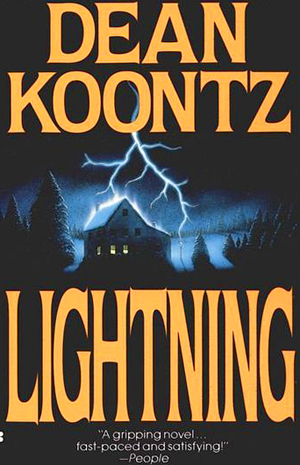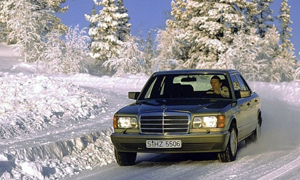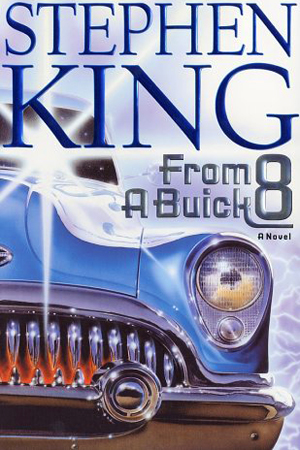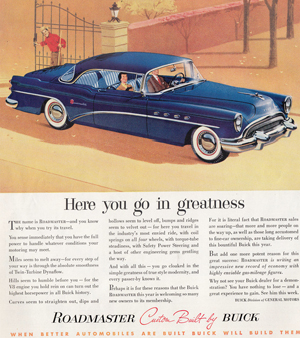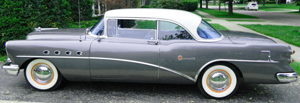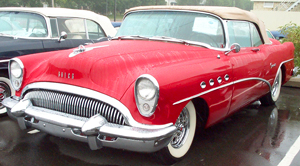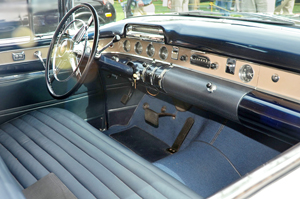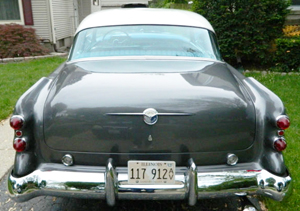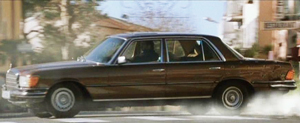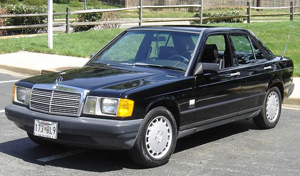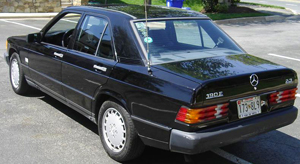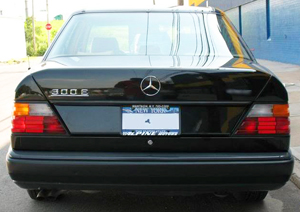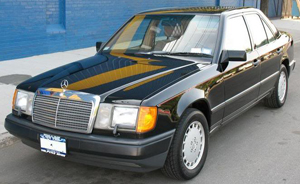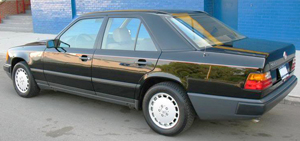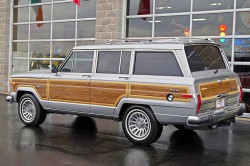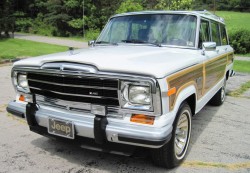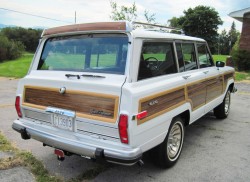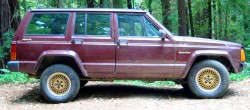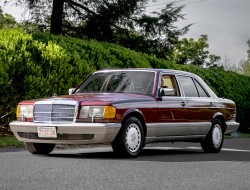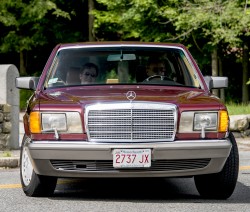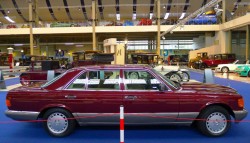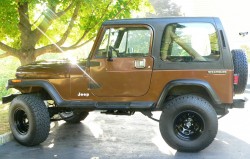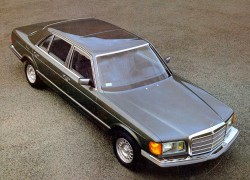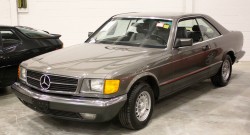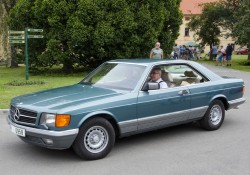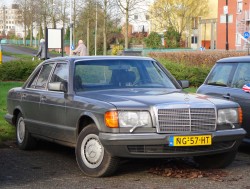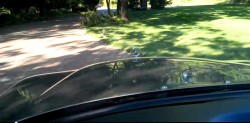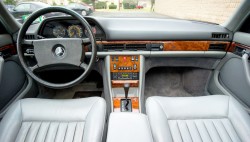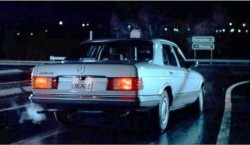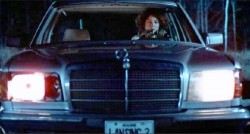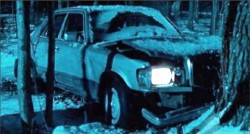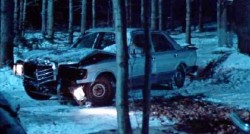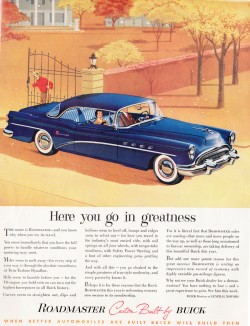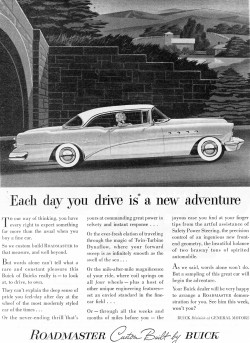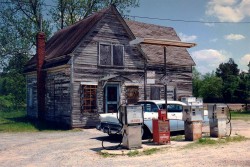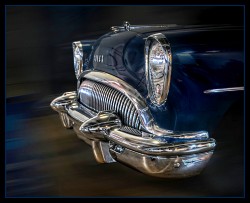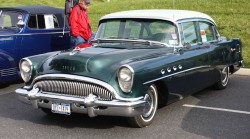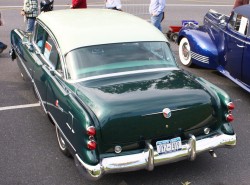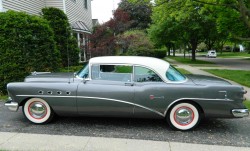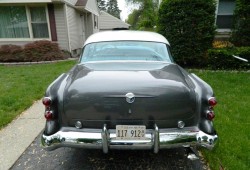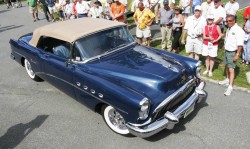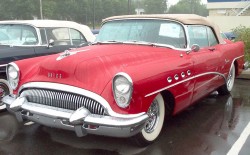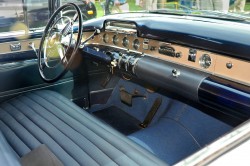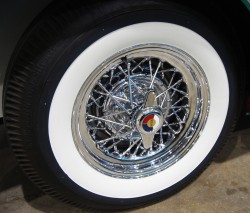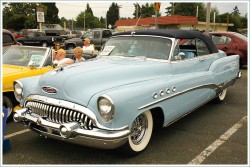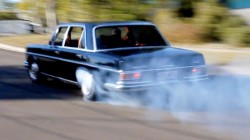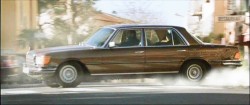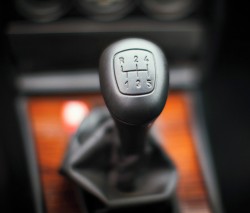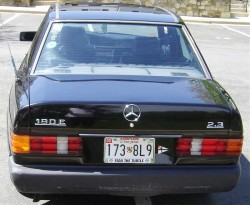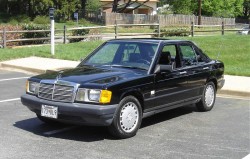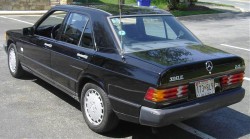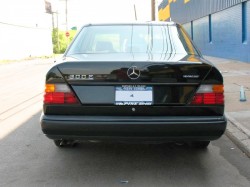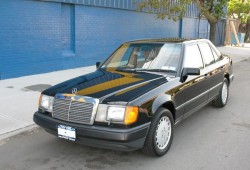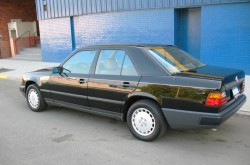(Continued from Part 1)
 If you’re like me when you read a work of fiction, you visualize things you read to a high degree. You form a mental picture of characters in the story based on people you know or know of. You visualize a setting with details in it that stir emotions. And if there are any automobiles that make an appearance somewhere across the pages, you want them to be described well enough to figure out the make, model, and year. Because being a car fanatic, you simply want to know. You value when the author describes them well, and your patience grows short when they don’t. When you realize a detail is inaccurate, you’re forced to either suspend disbelief, ignore it, or overrule it by willfully picking another detail for your mind’s eye to hold onto.
If you’re like me when you read a work of fiction, you visualize things you read to a high degree. You form a mental picture of characters in the story based on people you know or know of. You visualize a setting with details in it that stir emotions. And if there are any automobiles that make an appearance somewhere across the pages, you want them to be described well enough to figure out the make, model, and year. Because being a car fanatic, you simply want to know. You value when the author describes them well, and your patience grows short when they don’t. When you realize a detail is inaccurate, you’re forced to either suspend disbelief, ignore it, or overrule it by willfully picking another detail for your mind’s eye to hold onto.
In Part II of this article series, we look at a few more cases of favorite authors that have written novels in the last four decades where a car makes a significant enough appearance on the pages to be described. As before, we left off automotive journalists or writers of repair manuals, historical books, and reference guides because their whole point is to be specific in the details. Instead we stuck to fiction authors who focus on telling another story – where the automobile is only secondary. Below are some of them, graded on the A-B-C-D-F scale for no other reason than to set some standards in our own minds…
Dean Koontz, LIGHTNING – 1988
Main character Laura Shane who finds success as a novelist soon finds herself also under attack from a militia that has the ability to travel out of the past to the present in their attempt to change the course of history. While some say Dean Koontz’s earlier work was formulaic, I’ve always enjoyed his ability to tell a story and pull the reader in. In the below passages from the story which take place January 10, 1989, Laura and her young son Chris must scramble to get away from her pursuers while carrying a wounded man who’s more guardian angel than friend to her. Laura takes her Mercedes 420SEL, and the pursuers jump in her “Jeep wagon” and give chase. While Koontz doesn’t mention what year the 420SEL is, that’s description enough since that model was produced from 1986-91 virtually unchanged. Whether it’s a 1986, ’87, ’88, or ’89 in the story, it would have a 201 horsepower V8 and look exactly the same on the outside. So we’ll give the author an A grade for the 420SEL. Because Laura was a woman of means, we are left to assume her Jeep was a newer one since Koontz doesn’t clarify if it has 2 doors (making it a Wrangler or Cherokee) or 4 doors (making it a Cherokee, or Grand Wagoneer). Details provided in the chase scene below seem to conflict what model Jeep it is, so Koontz earns a D- grade for the Jeep.
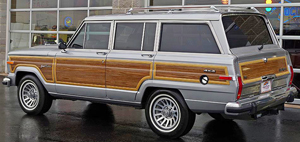
Koontz gives no clarification of what Jeep model is involved in his novel Lightning, except that it is a “Jeep wagon“. His use of tailpipes (plural) hints at a V-8 engine, making us believe he was thinking of a Grand Wagoneer (other Jeep models only offered 4- or 6-cylinder engines). However, neither the Grand Wagoneer nor any models from Jeep were available with a factory dual exhaust option during the 1980s, so that imagined detail proves inconclusive.
They had a little trouble easing across the door still at the end of the laundry room, but they got him into the three-car garage. The Mercedes was on the left, the Jeep wagon on the right, with the middle slot empty. They wheeled her guardian to the Jeep. Chris had opened the tailgate. He had also unrolled a small gym mat in there for a mattress. Together they had managed to transfer the wounded man from the dolly into the cargo bed by way of the open tailgate …She saw that Chris had started the Jeep’s engine when he’d heard the gunfire; bluish exhaust fumes billowed from the tailpipes.
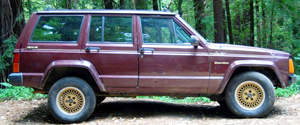
It’s also possible that Laura’s “Jeep wagon” was a 1980s Jeep Cherokee, which was available in 2- and 4-door form (1988 model shown here).
… Slugs slammed into the side of the Jeep, and the window behind her blew in, but the window beside her remained intact. The killers had arrived at her house without a vehicle – God only knows how they had traveled, perhaps with the use of one of those strange belts – and they were using her Mercedes to pursue her.
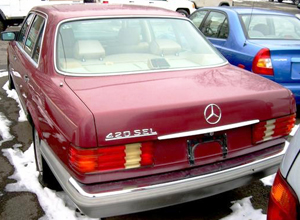
While Koontz doesn’t mention what year Laura’s Mercedes 420SEL is, that’s description enough since that model was produced from 1986-91 virtually unchanged. Whether it’s a 1986, ’87, ’88, or ’89 in the story, it would have a 201-horsepower V8 and be essentially the same. So we’ll give the author an A grade for the 420SEL. (1988 model shown)
…The Mercedes was on the state route now, out of sight most of the time because the roadway rose and fell and twisted, putting hills and turns between the two vehicles. The car seemed to be about two hundred yards behind, but it was probably closing because it had a bigger engine and a lot more power than the Jeep
“….How’s our passenger back there?” she asked. Without unfastening his safety harness, Chris turned to look into the back of the Jeep wagon. “He looks okay, I guess. He’s getting bounced around a lot.”

The 201-horsepower V8 engine in all 420SEL models (1988 shown here) would have had no difficulty catching up to any Jeep of that time period on a straightaway. We felt Koontz deserved an overall grade of A for describing the Mercedes.
…Behind them the Mercedes had closed the distance to about one hundred yards. It was a road-hugger, a 420SEL, which handled as well as anything on the highway, much better than the Jeep…The Mercedes closed, and the driver flicked the headlights from low beam to high beam again and again, as if gleefully saying, Hey here we come, Laura, we’re gonna get you, we’re the boogeymen, the real thing, and nobody can run from us forever, here we come.
The Mercedes was about fifty yards back, closing fast. Light traffic passed them going the other way, and she got behind another car in their lane, a gray Volvo, around which she whipped on an almost blind stretch of road, but she had no choice because the Mercedes was within forty yards. The killers passed the Volvo with equal recklessness…

The facts that bullets fired by antagonists “punched a hole through the tailgate window and thudded into the back of the seat where she and Chris were riding” leads us to believe Laura’s Jeep might have been a Wrangler – because rear seats were minimally sized, and sometimes not present at all (1987 model shown).
When she was two-thirds of the way along the south shore of the lake, pushing the Jeep as fast as she dared, with the Mercedes just thirty-five yards behind, she saw the ridge road turnoff ahead…As she recalled, the ridge road was paved for a couple of miles at each end but was only a graded dirt lane for six or seven miles in the middle. Unlike the Jeep, the Mercedes did not have four-wheel-drive; it had winter tires, but they were not currently equipped with chains. The men driving the Mercedes were unlikely to know that the pavement would give way to a rutted dirt surface patched with ice and in some places drifted over with snow.
She didn’t use the brakes until the last moment, taking the right turn onto the ridge road so fast that the Jeep slid sideways with a tortured squeal of tires. It shuddered too, as if it were an old horse that had been forced to make a frightening jump. The Mercedes cornered better, though the driver had not known what she was going to do. As they headed into higher elevations and greater wilderness, the car closed the gap to about thirty yards. Twenty-five. Twenty.
…She did not hear the gunfire itself but heard bullets smacking into the Jeep, and a slug punched a hole through the tailgate
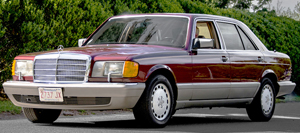
In the story, the Mercedes 420SEL (1988 model shown) was “about two hundred yards behind, but it was probably closing because it had a bigger engine and a lot more power than the Jeep.” Technically, the 420SEL’s engine was only 4.2 liters in size – smaller than any Grand Wagoneer’s would have been but larger than a Wrangler or Cherokee’s.
window and thudded into the back of the seat where she and Chris were riding; she felt as well as heard its solid impact. She had to use the side mirrors instead of the rear view. Though most of the tailgate window was intact, the safety glass was webbed with thousands of tiny cracks which left it translucent and useless….
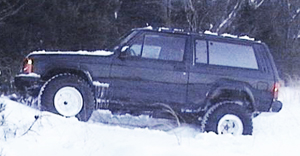
A relatively light weight Jeep Cherokee (1988 2-door model shown) in four-wheel-drive mode would handle trails filled with slippery mud and snow quite well, and leave any Mercedes from that time period in the dust. But conflicting details about the Jeep in the story led to us giving Koontz a grade of D for his vague description.
She topped a rise, and the pavement ended halfway down the hill ahead of them. She stopped weaving, accelerated. When the Jeep left the blacktop, it shimmied for a moment, as if surprised by the change in road surface, but then streaked forward on the snow-spotted, ice-crusted frozen dirt. They jolted across a series of ruts, through a short hollow where trees arched over them, and up the next hill.

Koontz’s description of the Mercedes 420SEL sliding and becoming stuck climbing a snow-covered incline is completely accurate. Without winter tires, these cars have poor traction in snow because of their rear-wheel-drive layout and lack of a limited slip differential.
In the side mirrors she saw the Mercedes cross the hollow on the dirt lane and start up the slope behind her. But as she reached the crest, the car began to founder in her wake. It slid sideways, its headlights swinging away from her. The driver overcorrected instead of turning the wheel into the slide, as he should have done. The car’s tires began to spin uselessly. It slid not only off to the side but backward twenty yards, until the right rear wheel jolted into the drainage ditch that flanked the road; the headlight beams were canted up and angled across the dirt track.
Stephen King, Gerald’s Game – 1992
 Set in Maine during early October of 1991.
Set in Maine during early October of 1991.
It’s interesting to note that this is the second work of fiction Stephen King published in 1992 that featured a large, gray Mercedes-Benz S-class in the story. In Gerald’s Game, married couple Jessie and Gerald Burlinghame are alone in the bedroom of their Maine summer house playing a game involving handcuffs that isn’t listed in Hoyle’s.
During the course of their play, Gerald, an out-of-shape attorney in his late 40s, suffers a massive heart attack and falls to the floor dead instantly. As Jessie is still handcuffed to the bed, she struggles with the realization that she is stuck there with no one nearby to come to her rescue. As she slips in between awareness, sleep, and a fugue state, she flashes back to earlier parts of her life as her subconscious mind tries to bring an effective escape plan to the surface. As Jessie lays cuffed to the bed with her “eight-year-old” Mercedes in plain sight just outside the back screen door, she’ll face a hungry stray dog and realistic apparitions that appear in the night.
While this is one of his less supernatural-based novels, Stephen King displays the full strength of his wry sense of humor and storytelling ability in the details. Similar to the earlier model S-class that makes an appearance in You Know They’ve Got a Hell of a Band (see Part 1 of this article), King describes the car well enough to convince us he’s owned with and lived with at least one of these flagship Mercedes-Benzes.
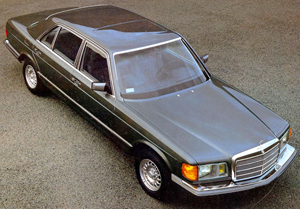
Considering that Gerald was making almost $100k a year in 1981, he could have easily afforded a top-of-the-line Mercedes long wheelbase sedan by 1983. King gives no clues on that note, but such a model would be either a 1983 380SEL or a 1984 500SEL. Either would look like the one shown here.
Since the story takes place in October 1991 and the Mercedes is eight years old, King is referring to either a 1983 or early-’84 model. Most likely he had a 1983 in mind writing the book during the spring and summer of 1991. There’s a reference to a back seat with enough room for an adult to sit in, so we know it’s not a two-seater SL. And since it’s described by Gerald as one of two “large German cars” they own, it must be an S-class model of some variation rather than a mid-size 300D diesel sedan, wagon, or coupe. The size descriptor would naturally rule out a compact 190E model introduced in the U.S. for the 1984 model year as well. A reference to a distributor cap means the car has a gasoline engine – ruling out an S-class diesel (300SD) and further ruling out all midsize 300D models because they were 100% diesel-powered then.
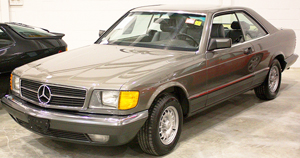
We weren’t sure at first if the Burlinghames’ Mercedes was an S-class coupe, which would make it either a 1983 380SEC (shown here) or an ’84 500SEC. However, a later mention of the hood ornament being knocked askew confirmed it would be a sedan, because coupe models feature the Benz emblem in the grille rather than on top of the hood.
We weren’t completely sure at first if the Burlinghames’ S-class was a coupe or a sedan. Assuming it’s a 1983 U.S. market model, the car would either be a 380SEC coupe or 380SEL long-wheelbase sedan. Move the model year ahead one to 1984 model, and you’ve got either a 500SEL long-wheelbase sedan, 380SE short-wheelbase sedan, or 500SEC coupe. Confused yet? However, a later mention of the vehicle’s hood ornament being knocked askew confirmed it has to be a sedan, because coupe models feature the Mercedes-Benz emblem in the grille rather than on top of the hood.
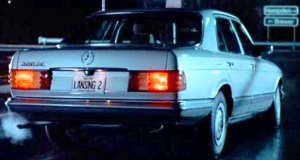
We also suspect the car Stephen King pictured in his mind writing Gerald’s Game was the Euro-market 1983 380SE that made an appearance four years earlier in his own movie Creepshow II – The Hitchhiker.
We also suspect the car Stephen King was picturing in his mind was the European-market 1983 380SE that made an appearance four years earlier in his own movie Creepshow II – The Hitchhiker. If you haven’t seen it, The Hitchhiker was a movie short that also centered on a woman with a lawyer husband who, fleeing a horrible specter, drives her gray S-class into a tree at a low speed then passes out. All of it sounds remarkably like Gerald’s Game.
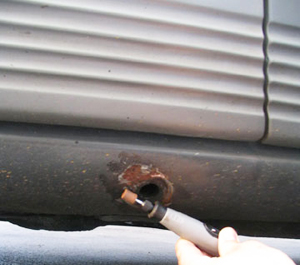
Stephen King’s description of the eight-year-old Mercedes showing speckles of rust along the rocker panels was dead on. All Benzes from the 1980s showed surface rust speckles at that point, as seen here on this 1983 S-class model.
… Jessie looked at the gray barnboard walls, the high white ceiling with its reflected shimmers from the lake, and the two big windows, one on either side of the bed. The one to her left looked west, giving a view of the deck, the sloping land beyond it, and the heartbreaking bright blue of the lake. The one on her right provided a less romantic vista – the driveway and her gray dowager of a Mercedes, now eight years old and beginning to show the first small speckles of rust along the rocker panels.
(According to Mirriam-Webster, one definition of dowager is an elderly woman of high social stature who is very formal or serious)
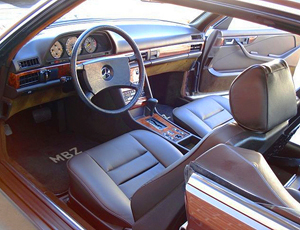
The words Stephen King used to describe rear seat access make us think more of an S-class coupe… “Gerald handed me the car-keys just before he got out of the car, so he could reach into the back seat and get his briefcase.” If the car was a coupe, a person would need both hands – one for pushing the seatback forward and the other for grabbing a briefcase.
…Ten years ago she had reluctantly given up on her job as a substitute teacher, finally giving into the pressure of Gerald’s persistent logic. He was making almost a hundred thousand dollars a year by then; next to that, her five to seven grand looked pretty paltry. It was in fact, an actual annoyance at tax time… “They see what I’m making, they see two large German cars in the garage…it looks phony to them.”
…Gerald handed me the car-keys just before he got out of the car, so he could reach into the back seat and get his briefcase.
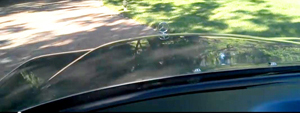
The driver’s seat view that Jessie would have enjoyed sliding behind the wheel of her gray 1983 Mercedes S-class sedan.
…She opened the driver’s door, slid behind the wheel of the Mercedes, and managed to pull her trembling legs in after her. She slammed the door and, as she pushed down the master-lock which locked all other doors (plus the trunk, of course; there was really nothing in the world quite like German efficiency), an inexpressible sense of relief washed over her
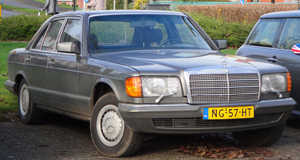
A better look at a gray short-wheelbase Mercedes S-class. Plastic wheel covers and flush aero headlights indicate this one is a European-market 380SE of 1983-84 vintage.
…The Mercedes was getting along in years (she wasn’t sure they ever really got anything so vulgar as old), and the transmission had started doing some annoying little tricks lately, German efficiency or no German efficiency. One of them was a failure to start sometimes unless the driver shoved up on the shift lever poking out of the console between the bucket seats, and shoved up hard
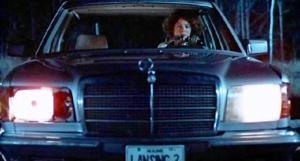
Creepshow II – The Hitchhiker (1987) was a Stephen King movie short that also centered on a woman with a lawyer husband who was fleeing a horrible specter in a gray 1983 S-class. In both stories, the hood ornament was knocked askew.
…Jessie whispered, and turned the ignition key again. Still nothing. Not even a click. And now a whole new idea stole into her head like a nasty-tempered little burglar: her inability to start the car had nothing at all to do with the little glitch that had developed in the transmission. This was more of her visitor’s work. It had cut the telephone lines; it had also raised the hood of the Mercedes long enough to rip off the distributor cap and throw it into the woods.
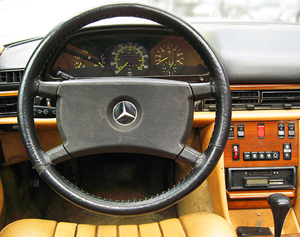
Stephen King makes an accurate reference to Jessie’s car not being equipped with a driver’s airbag the way a later one would have been. Mercedes S-class models were not equipped with them before 1985, so an ’83 or ’84 model would have steering wheel that looked like this.
…Then she fell forward toward the wheel in a faint. As the Mercedes struck one of the large pines which bordered this section of the road, the seatbelt locked and jerked her backward again. The crash probably would have triggered the airbag, if the Mercedes had been a model recent enough to have come equipped with the system. It was not hard enough to damage the engine or even cause it to stall; good old German efficiency had triumphed again.
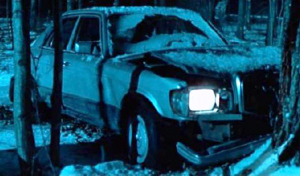
Scene from Steven King’s Creepshow II – The Hitchhiker (1987) where the main character passes out and drives her 1983 Mercedes 380SE into a tree at low speed. A story with a number of similarities to Gerald’s Game.
The bumper and grille were dented and the hood ornament was knocked askew, but the engine idled contentedly away to itself. After about five minutes, a microchip buried in the dashboard sensed that the motor was now warm enough to turn on the heater. Blowers under the dash began to whoosh softly.
Overall, we gave Stephen King a slightly better than average C+ grade on the description of the Mercedes here because while details supplied were good, they were not complete enough to form a complete and immediate picture of the vehicle.
Stephen King, FROM A BUICK 8 – 2002
In the Author’s Note section, Stephen King describes how he got the idea for this book while driving back from Florida to Maine in late March of 1999. Stopping at a gas station in western Pennsylvania, he walked down a steep slope behind the station to take a breather and get a better look at a roaring stream at the bottom of the slope. He slipped on some wet mud and slid down the slope towards the water. Had the yard not been littered with old rusty auto parts, he would have not been able to grab onto something to prevent going into the river – where, as he says, all bets would have been off for survival. As King got back to his Dodge truck and paid the attendant, who had been unaware of the incident, he wondered how long his truck loaded with furnishings and bright Flordia clothes would have sat there before the attendant got nervous. Whom would he have called? How long before anyone would have found him if he’d drowned?
King opens this story in a similar fictional Pennsylvania location during 1979, where a gas station attendant, Bradley, hears a car roll up to the pumps. By the time he comes out of the building and approaches the pumps, all he can see is the vehicle owner walking around the side of the building – presumably to use the bathroom. A long black overcoat hides much of what the owner looks like, and the attendant can only tell that he appeared very strange – with a face that looked melted. After uttering “Fill ‘er up” in a squid-like voice, the car owner disappears around the corner – never to return.
He calls the state police, who come and eventually impound the car. But when they realize it seems more like a mockup of a 1954 Buick than a real functioning one, they discover it does very strange things all by itself. The police keep the car hidden in a storage shed for decades, for fear of letting it out to the public.
We’ll give King a B grade here because the ’54 Buick Roadmaster was described with good detail but not enough to discern if this was a coupe, convertible, or sedan. We’ll rule out station wagon because there’s continuous to the trunk compartment as well as the trunk lid. Importance should be placed on that detail because the different models had different profiles entirely.
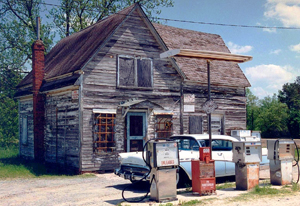
Stephen King based Buick 8 on an experience that he himself had at a rural gas station in late March of 1999.
…At around ten o’clock on a morning in July, Brad Roach was sitting in the office of the service station with his feet up, reading Inside View. On the front was a picture of a flying saucer hovering ominously over the White House. The bell in the garage dinged as the tires of a vehicle rolled over the hose on the tarmac. Brad looked up to see a car – the very one which would spend so many years in the darkness of Shed B – pull up to the second of the station’s two pumps. It was a beautiful midnight blue Buick, old (it had the big chrome grille and the portholes running up the sides) but in mint condition.
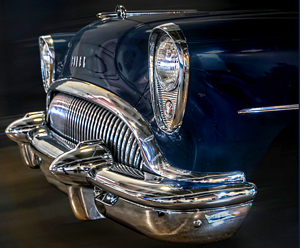
The front end of all 1954 Buick Roadmaster models looked the same, as seen here. We’ll give King a B grade for Buick 8 because the ’54 Buick Roadmaster was described with good detail but not enough to discern if this was a coupe, convertible, or sedan. We’ll rule out station wagon because of repeated references to the trunk compartment and the trunk lid which a wagon would not have.
The paint sparkled, the windshield sparkled, the chrome side-strike along the body sparkled, and even before the driver opened the door and got out, Bradley Roach knew there was something wrong with it. He just couldn’t put his finger on what it was. He dropped his newspaper on the desk and got up just as the Roadmaster’s driver opened his door on the far side of the pumps and got out. The man who got out of the car was dressed in a black trench coat and a large black hat…The trench coat, in fact, was so long it nearly dragged on the puddly cement tarmac, and it billowed behind the Buick’s driver as he strode toward the side of the station and the sound of Redfern Stream, which ran behind it.
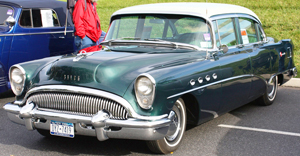
A midnight blue 1954 Buick Roadmaster sedan. From the windshield back, the four-door has an entirely different profile than two-door models.
…Brad, assuming that the man in the black coat and floppy black hat was headed for the seat of convenience, called “Bathroom door’s open mister, how much of this jetfuel do you want?” “Fill ‘er up,” the customer said. He spoke in a voice Brad Roach didn’t much like. What he told the responding officers later was that the guy sounded like he was talking through a mouthful of jelly… “Check the earl?” Brad asked. By this time his customer had reached the corner of the little white station.
Judging by how fast he was moving, Brad figured he had to offload some freight in a hurry. The guy paused, though, and turned toward Brad just a little. Just enough for Brad to see a pallid, almost waxy crescent of a cheek, a dark, almond-shaped eye with no discernible white in it, and a curl of lank black hair falling beside one oddly made ear…Melted, kinda, like he’d been in a fire.
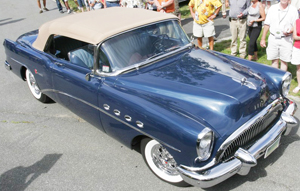
We couldn’t find specific enough references to the 1954 Buick Roadmaster in the story to rule out whether it might have been a convertible such as the one shown here.
“Oil’s fine!” the man in the black coat and hat said in his choked voice, and was gone around the corner in a final batlike swirl of dark cloth. In addition to the quality of the voice – that unpleasant mucusy sound – the man had an accent that made Brad Roach think of the old Rocky and Bullwinkle show.
(When the owner went missing and never returned to claim the Buick, Pennsylvania state troopers down the road were called. Upon arriving, they examined the car closely)
“It’s a Buick, I can tell that much by the portholes and the grille. Must be from the mid-fifties, wouldn’t you say?” Actually, it was a ’54…sort of a ’54. When you got right down to it, it wasn’t a 1954 at all. Or a Buick. Or even a car.
“The first thing’s the engine,” Curt said. “No, I suppose the first thing’s the hood latch. It’s way over on the driver’s side, and you push it in rather than pulling it out…There’s an engine, but it’s all wrong. It says
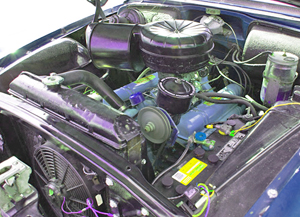
We enjoyed King’s level of detail given to how the 1954 Buick Roadmaster in the story did not have parts that moved or functioned the way a real automobile would. “All stage dressing.” The fact that it wouldn’t run or be drivable baffled everyone.
BUICK 8 on both sides of the engine block in big chrome letters, as if whoever made it was afraid of forgetting what the damn thing was. There are eight plugs, four on each side, and that’s right – eight cylinders, eight spark plugs – but there’s no distributor, not that I can see. No generator or alternator, either…Each spark plug wire makes a big loop and goes right back into the engine block as far as I can tell…It’s got a radiator, but so far as I can tell, there’s nothing inside it. No water and no antifreeze. There’s no fan belt, which sort of makes sense, because there’s no fan…There’s a crankcase and a dipstick, but there’s no markings on the stick. There’s a battery, a Delco, but dig this, it’s not hooked up to anything. There are no battery cables.
“The dashboard controls are all fake, just stuck on there for show. The radio knobs don’t turn and neither does the heater control knob”. “What the hell we got here?…A car that can’t drive and can’t steer cruises into the Jenny station out on Route 32 right up to the high test pump. No sticker…” An idea struck him. “Registration? You check for that?”
“Not on the steering post,” Curt said, opening his door, impatient to get out. “Not in the glove compartment, either, because there is no glove compartment. There isn’t a handle for one, and there’s a latch button, but the button doesn’t push, the handle doesn’t pull, and the little door doesn’t open. It’s just stage dressing, like everything else on the dashboard. The dashboard itself is bullshit. Cars didn’t come with wooden dashboards in the fifties. Not American ones, at least”
“Trunk? Does that open?”
“Yeah, it’s not locked. Push the button and it pops open like the trunk of any other car. But it smells lousy.”
“Lousy how? Any dead bodies in there?”
“Swampy. No bodies, no nothing…No spare tire”
“No antenna for the radio”, Ennis continued, “and no mud on the body. How’d it get up Route 32 without getting some
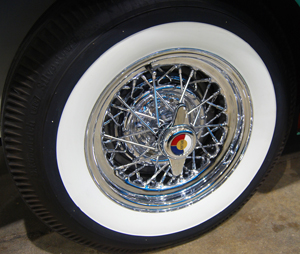
King’s description of how the Buick sat on “fat, luxy whitewalls” makes it easy to picture these factory original wire wheels being present. However, that detail wasn’t specified.
mud on it? We were splashing up puddles everywhere. There’s even crud on the windshield.”… “All old Buicks have portholes. But these are wrong. There’s four on the passenger side and only three on the driver’s side. Do you think Buick ever rolled a model off the line with a different number of portholes on the sides? Cause I don’t.”
In the Author’s Note section, Stephen King acknowledges the discrepancy between the ’53 Roadmaster on the book’s cover and the one in the story, which was repeatedly described as a ’54. “Scribner would not let me close this note without pointing out that certain liberties have been taken with the Buick on the book jacket. GM-ophiles
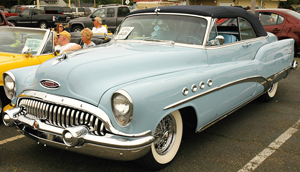
A 1953 Buick Roadmaster like the one on the cover of Buick 8, slightly different-looking than the ’54 model in the story.
will likely notice that the Eight’s cover girl is older than the Buick in the story. I was asked if this little cheat bothered me, and I said absolutely not. What bothers me, especially when it’s late and I can’t sleep, is that sneermouth grille. Looks almost ready to gobble someone up, doesn’t it? Maybe me. Or maybe you, my dear Constant Reader. Maybe you.”
Sue Grafton, V is for Vengeance – 2011
 Storyline for the passages below is set on April 22, 1988
Storyline for the passages below is set on April 22, 1988
“V” Is for Vengeance is the 22nd novel in Sue Grafton’s alphabet series of mystery novels centering around a female private detective living in California. In the story, she witnesses two women shoplifting in a Nordstrom’s store. She tells a nearby clerk who alerts store security, and they capture and arrest one of the women. The private eye follows the other one that escaped into a parking garage and is almost run over by her in the parking garage.
Right after her release from jail, Audrey apparently commits suicide. Shortly thereafter, Millhone runs into a former boyfriend in the police department, Cheney Phillips, who is out for the evening with a vice officer, Len Priddy (a friend of Millhone’s first husband and a longtime enemy of hers), and his much-younger girlfriend, Abbey. Priddy mocks the theory that Audrey was part of a shoplifting ring, but Audrey’s boyfriend hires Millhone to investigate that theory.
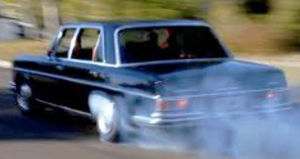
A 1972 300SEL 6.3 would be one of a limited number of Mercedes-Benz sedans made before 1988 that can spin the rear tires out of brute torque…
As mentioned in Part 1 of this article, it was a question my wife asked me while reading this book that prompted me to re-read some old favorites. “Could a Mercedes sedan that would have been around in 1988 do a tire-smoking burnout, on a smooth cement parking garage surface?” Having owned and driven a succession of older 1980s era Mercedes models, she knew she’d never encountered one. “Well, if it was an early-’70s 300SEL 6.3 or maybe a later-’70s 450SEL 6.9, maybe.” Those models were low-production versions of standard S-class sedans that had large (for any decade) V-8 engines stuffed under the hood. Both of them commanded extremely high price tags, and were rare enough that the sight of one would have been a
once-in-a-blue-moon kind of thing. Not your everyday Mercedes sedan, and not one you’d be likely to come across. In other words, they are special cars that only an enthusiast would seek out – in any year. Nobody ever owned one by accident.

A Mercedes-Benz 5-speed manual transmission offered on 1980s 190E and 300E models would have allowed enough wheelspin to create a fishtail effect, but 99% of those built for the United States were equipped with automatics.
When my wife indicated V is for Vengeance was set in 1988, I asked, “Was the car a 300E or a 190E with a stick shift? It’d be possible in one of those.” She scanned the book for such clues but found the author had supplied no details about the car other than it being a black Mercedes sedan, and that a woman driving it in the story had tried to mow down a female private eye who was the main character of the book – fishtailing in reverse across a parking garage.
Thinking about it more, I commented, “If it was an S-class, a big one, the author probably would have described it as a big Mercedes. They always do.” So if it wasn’t an S-class sedan, it wouldn’t have had a V8. Mercedes engines always made good horsepower for their day, but they produced horsepower that translated to high speed at high revvs on
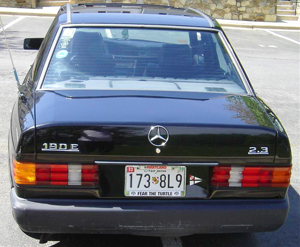
Rear image of 1984 through 1988 190E, a gasoline-powered model that could catch wheelspin if equipped with a manual transmission. (1986 model shown)
a highway, not tire smoking burnouts that would cause a fishtail. And if you’ve ever tried to find a U.S.-market 300E or 190E with a stick shift, you know that 99% of them were built with automatic transmissions. I wondered if the author had any clue of these details. Mercedes-Benzes with enough power to do tire-melting burnouts were common by 2011, so maybe Sue Grafton just assumed without researching it that anything up to 1988 would have been the same.
Not knowing exactly how old the car was in 1988 gave little reference point. We doubted Sue Grafton was visualizing a diesel model which made up 85% of all Mercedes-Benz sales in the United States through 1985. And because it wasn’t described as a “big black Mercedes”, we thought a gasoline model 1984-88 190E or 1986-88 300E would fit with the descriptions below. Grafton gets a failing grade of F from us because the car in the story was so vaguely described – indicating there wasn’t much interest on the part of the writer in gaining enough knowledge to supply either clues or accuracy.
…I trotted into the empty lane and scanned the straightaway that shot to the far end of the garage, where a shadowy two-lane ramp curved up to the street level above… I heard a car engine spark to life. I squinted and tilted my head as I tried to track the sound of its origin. In the artificial light of the garage with its gloomy acres of concrete, it was almost impossible to pinpoint.
I turned and looked behind me, where twenty feet away I caught the wink of red tail lights and a white flash of backup lights. A black Mercedes sedan accelerated out of the slot, swung sharply, and careened backward in my direction. The younger woman had an arm over the front seat, zeroing in on me, the car zigzagging as she corrected her aim. The rear of the Mercedes fishtailed and bore down on me with surprising speed.
…I leaped between two parked cars, banging my shin against the front bumper of one. I stumbled and and toppled sideways, extending my right hand in hopes of breaking the fall. I went down on one shoulder and then staggered to my feet again. The woman rammed the gear into Drive and took off with a chirp of her tires. Of necessity, she slowed at the kiosk, handing over her ticket while I limped gamely after her with no hope of catching up. The attendant glanced at her ticket and waved her on,
apparently unaware that she’d just tried to run me down. The traffic arm lifted and the woman sent me a satisfied smile as she sailed up the ramp and hung a left at the street.
BELOW ARE FULL-SIZE IMAGES OF THE ONES FEATURED ABOVE IN THE ARTICLE. CLICK ON ANY ONE TO OPEN, THEN USE SMALL ARROW BUTTONS UNDER EACH PICTURE TO SCROLL BACK AND FORTH.
- 1988 JEEP GRAND WAGONEER
- 1989 JEEP GRAND WAGONEER
- 1989 JEEP GRAND WAGONEER
- 1988 JEEP GRAND CHEROKEE
- 1988 MERCEDES 420SEL
- 1988 MERCEDES 420SEL
- 1988 MERCEDES 420SEL
- 1987 JEEP WRANGLER
- MERCEDES S-CLASS ON SNOW COVERED INCLINE
- (1983 MERCEDES 380SEL). Long-wheelbase 126 bodies came first to the United States as 1981-83 380SELs
- 1983 MERCEDES 380SEC. The SEC coupe was introduced for the 1982 model year. U.S. SECs were equipped with only the largest V8 the company offered each year through 1991.
- 1984 MERCEDES 500SEC (Euro market)
- 1983 MERCEDES 380SE (European model)
- Driver seat view in a 126-body Mercedes S-class (1980-91)
- 1983 MERCEDES 380SEL interior (without airbag)
- 1983 MERCEDES 380SE, from Stephen King’s Creepshow 2
- 1983 MERCEDES 380SE, from Stephen King’s Creepshow 2
- 1983 MERCEDES 380SE, from Stephen King’s Creepshow 2
- 1983 MERCEDES 380SE, from Stephen King’s Creepshow 2
- 1954 BUICK ROADMASTER coupe ad (900 x 1174)
- 1954 BUICK ROADMASTER ad (1024 x 1408)
- BUICK ROADMASTER at a remote gas station
- 1954 BUICK ROADMASTER front end
- 1954 BUICK ROADMASTER sedan
- 1954 BUICK ROADMASTER sedan
- 1954 BUICK ROADMASTER hardtop coupe
- 1954 BUICK ROADMASTER coupe rear view
- 1954 BUICK ROADMASTER convertible
- 1954 BUICK ROADMASTER convertible
- Interior of a 1954 BUICK ROADMASTER
- 1954 BUICK factory wire wheel
- 1953 BUICK ROADMASTER
- 1972 MERCEDES 300SEL 6.3 sedan
- 1979 MERCEDES 450SEL 6.9 sedan
- Mercedes 5-speed manual transmission, equipped on some 1980s 190E and 300E models.
- 1986 MERCEDES 190E rear view
- 1986 MERCEDES 190E three-quarter view
- 1986 MERCEDES 190E left rear view
- 1986 MERCEDES 300E rear view
- 1986 MERCEDES 300E left front view
- 1986 MERCEDES 300E left rear view

